
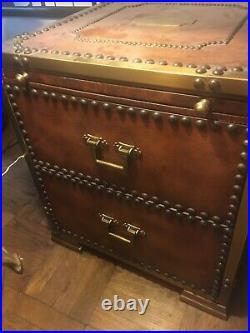
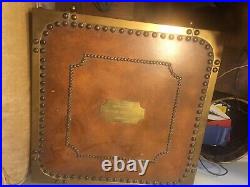
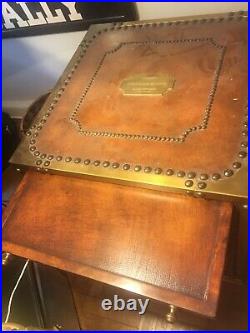

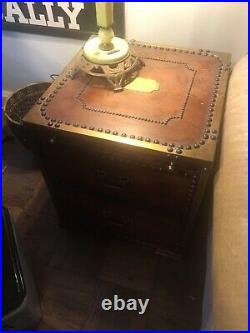
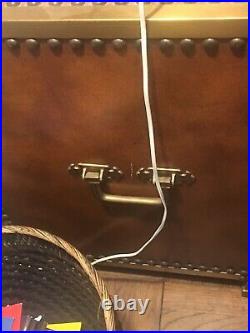

S Intrepid (L11) Royal Navy Captain William P. 24 x 24 x 24. S Intrepid (L11) Royal Navy. For other ships with the same name, see HMS Intrepid. HMS Intrepid (L11) was one of two Fearless-class amphibious warfare ships of the Royal Navy. A landing platform dock (LPD), she served from 1967 until 1999. Based in HM Naval Base, Devonport, Plymouth, Devon and HM Naval Base Portsmouth, she saw service around the world over her 32-year life. Ordered: 1 May 1962. Builder: John Brown & Company. Laid down: 19 December 1962. Launched: 25 June 1964. Commissioned: 11 March 1967. Decommissioned: 31 August 1999. “Cela va sans dire”. (“That goes without saying”). Fate: Towed to Liverpool for scrapping September 2008. Class and type: Fearless-class landing platform dock. 11,060 long tons (11,240 t) standard. 12,120 long tons (12,310 t) full load. 16,950 long tons (17,220 t) ballasted and dock flooded. 520 ft (158.5 m) oa. 500 ft (152.4 m) wl. Beam: 80 ft (24.4 m). Draught: 20 ft 6 in (6.25 m). 2 English Electric Steam turbines. 2 Babock & Wilcox boilers 550 psi (3,800 kPa) at 850 °F (454 °C). 22,000 shp (16,000 kW). Speed: 21 kn (39 km/h; 24 mph). Range: 5,000 nmi (9,260 km; 5,750 mi) at 20 kn (37 km/h; 23 mph)[2]. Boats & landing craft carried. 4× LCM (9) landing craft in dock. 4× LCVP landing craft on davits. Normal capacity 380400 troops, up to 700 troops for short periods[2]. 550 including small Royal Marines detachment (approx 88) and 2 Army Troops (Until 1973)[2]. Type 974 search radar. Type 978 Navigation radar[2]. Original armament:4× Sea Cat SAM launchers. 2 × Bofors 40/60. 4× Oerlikon KCB 30 mm cannon (2 twin mounts). 2× Oerlikon GAM-B01 20 mm cannon. Up to 5 Westland Wessex helicopters. She landed troops in amphibious assaults on the Islands and the Argentine surrender was signed on her deck at the conclusion of the Falklands War. Main article: Fearless-class landing platform dock. The LPDs provided support to a Royal Marines amphibious assault force and provided a platform for the Headquarters capability prior to, and during, the assault phase. Intrepid was the second of her class of purpose built LPDs used by Royal Navy. She was built in Clydebank, West Dunbartonshire, at the John Brown & Company yard and was launched in 1964 before undergoing trials and commissioning in 1967. The LPDs were intended to provide both a heavy lift for amphibious operations and to support a one star (Brigade) Headquarters afloat. As originally designed they could carry a load of 15 Main Battle Tanks (MBTs), 5 Self Propelled Guns, 8 recovery and engineer vehicles, 6 x 3 Ton trucks with trailers and 28 Landrovers and trailers, in essence an Armoured Battle Group, or any equivalent load. Accommodation was also provided for up to 450 troops. The ships were equipped with an extensive array of communications equipment and an Amphibious Operations Room (AOR)linked to the Main Communications Office (MCO) and adjacent to the ships own Operations Room on 03 deck. The AOR was used by the Brigade Headquarters until it moved ashore. In addition to HQ 3 Commando Brigade, it could also be used by the army Brigade designated for amphibious operations. In the early 1970s this was Headquarters 24 (Airportable) Brigade based at Plymouth. The army subsequently decided to disband both units and this took place on 3rd December 1973 at Devonport. Subsequently both roles were taken over by the Royal Marines. In November 1967, Intrepid formed part of a naval task force deployed to cover the British Withdrawal from Aden. [4] On 29 March 1968, Intrepid and the frigate Tartar were deployed to patrol off the Greater and Lesser Tunbs, small islands in the Persian Gulf, to deter Iran from occupying the islands. Intrepid became the first Royal Navy warship equipped with satellite communication equipment in 1969. The 1970 Bhola cyclone was a devastating tropical cyclone that struck East Pakistan (present-day Bangladesh) and India’s West Bengal on 3 November 1970. It remains the deadliest tropical cyclone ever recorded and one of the deadliest natural disasters. Melting snow from the Himalayas met the storm surge that flooded much of the low-lying islands of the Ganges Delta. HMS Intrepid with HMS Triumph left Singapore for the Bay of Bengal to assist with the relief efforts. Force controlled twenty helicopters, eight landing craft, 650 troops, and assisted international and civilian rescue teams distributing supplies. At least 500,000 people lost their lives in the storm. Sailors and Soldiers had to help bury the dead. A hard duty for which Navy Rum, a 200-year tradition which had recently ceased, had to be re-instated. As a result of defence cuts, Intrepid went into reserve in 1976, being brought back into active service in 1979 to allow Fearless to be refitted. It was announced in 1981 that the two LPDs were to be deleted, with Intrepid undergoing decommissioning in 1982 at the outbreak of the Falklands War. Intrepid was commanded by Captain Peter Dingemans. With elements of 3 Commando Brigade embarked, Intrepid took part in the amphibious landings at San Carlos Water. HMS Intrepid was under attack in San Carlos Water on 25 May 1982, with a few fatalities, mainly Royal Marines. [citation needed] Nordic Ferry was also under attack. She came under heavy air attack once again during the operation, and was the main participant in the landings at Bluff Cove on 6 June. Margaret Thatcher and Sandy Woodward commended the efforts of the ships involved in the San Carlos attacks. As well as being one of the warships used for imprisoning the Argentine prisoners of war, the surrender ending the Falklands conflict was signed on Intrepid’s deck. Intrepid was refitted at Devonport Royal Dockyard between January 1984 and June 1985, with two Sea Cat launchers removed, with twin 30 mm anti-aircraft mounts and two single 20 mm cannon added. From June 1985 until 1990 she supported the sea training phase of initial officer training, undertaken at Britannia Royal Naval College, as part of the Dartmouth Training Squadron. During the same period Intrepid also provided Marine Engineering Artificer Apprentices from HMS Sultan their sea training opportunity. During a three to four-month period, each entry of Artificers would spend a week working in each department aboard in order to learn more about the other trades in the Royal Navy. Intrepid was placed in reserve status late in 1990, when Fearless completed an extensive refit. Intrepid was in poor physical condition by this time, which prevented a similar upgrade, and was laid up at HM Naval Base Portsmouth. [6][8] Intrepid was used as a source of spares for Fearless. She was decommissioned in 1999 and awaited her disposal, by scrapping, in Fareham Creek, Hampshire. On 12 February 2007, the MoD announced that HMS Intrepid was to be recycled at a British facility. Having received the required planning permission and environmental licences for disposal, Intrepid left Portsmouth for her final journey to Liverpool on 13 September 2008. The item “H. M. S Intrepid (L11) Royal Navy Captain William P. Smyth Bureau Mahogany Leather” is in sale since Tuesday, June 22, 2021. This item is in the category “Collectibles\Transportation\Boats & Ships\Military\Other Naval Collectibles”. The seller is “erice29″ and is located in New York, New York. This item can be shipped to United States.
- Country/Region of Manufacture: United Kingdom
- Modified Item: No
- California Prop 65 Warning: n/a

